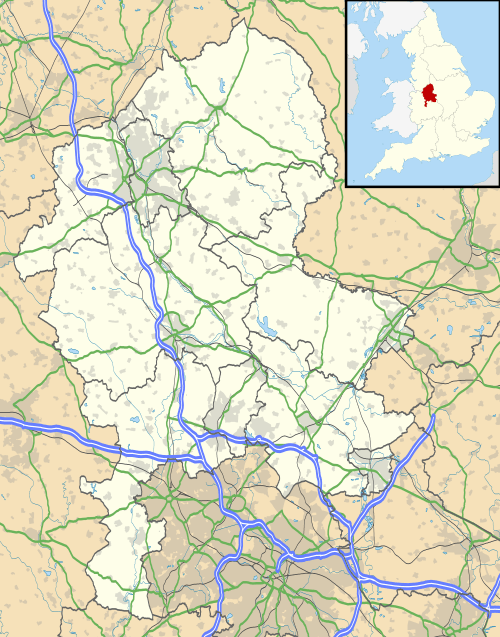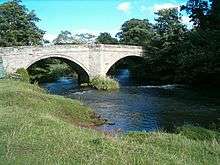Ellastone
Ellastone is a rural village in the West Midlands of England on the Staffordshire side of the River Dove, between Uttoxeter and Ashbourne in north Staffordshire.
| Ellastone | |
|---|---|
 Ellastone Location within Staffordshire | |
| Population | 320 (2011)[1] |
| OS grid reference | SK116429 |
| District | |
| Shire county | |
| Region | |
| Country | England |
| Sovereign state | United Kingdom |
| Post town | Ashbourne |
| Postcode district | DE6 |
| Police | Staffordshire |
| Fire | Staffordshire |
| Ambulance | West Midlands |
Geography
Ellastone lies on the River Dove and is a hive of fluvial activity. Two small brooks (Sandford Brook and Tit Brook) flow directly into the River Dove. Additionally there is a natural spring, still officially known as Bentley Well, which flows into the Tit and sits on former farmland which is now occupied by a new development, Bentley Fold. The Dove is the historic boundary between the two counties of Derbyshire and Staffordshire, and some of its crossings and bridges were once important elements of the main coaching road from London to the ports of the North-West.
The modern village
Today the village, despite being on the busy B5032 road, misses out on the majority of the traffic for the often crowded Alton Towers theme park, which leaves the road just to the south at the J. C. Bamford World Headquarters in Rocester. Due to this, Ellastone residents do not receive free Alton Towers tickets despite its proximity to the attraction. The village does however attract some foot and horse tourism, as it lies near the southern end of the Limestone Way, a long distance bridleway.
Ellastone's current amenities include a village hall, tennis court, bowling green, park and snooker club.
Although Ellastone is on the Staffordshire side of the border, it currently has a Derbyshire postal address because the nearest postal town of Ashbourne is in Derbyshire.
History
Ellastone, a linear village, situated close to the River Dove, on the border between Derbyshire and Staffordshire. The village can be traced back to Anglo-Saxon times in documentation and it features in the Domesday Book, where it is listed as Edelachestone, Elachestone[2] and as Princestone. The Ellastone Parish Register (1907) records the variant spellings, to be found in early medieval manuscripts, as: "Edelachestone, Elachestone, Ethelaxton, Ethelaston, Adlaxton, Athelaxton, Adelachestone, Adalacheston, Edelestone."
One of the village cottages was once owned by William Cecil, the influential politician and confident of Elizabeth I. That was probably due to that part of the Peak then being on the main road to London, as evidence by the later coaching route.
The local church of St. Peter's dates back to the 16th century with the year 1586 displayed on the tower.
Ellastone was served by a railway station (shared with Norbury) which was opened by the North Staffordshire Railway on 31 May 1852.
During World War II, the bridge over the River Dove was an important crossing point, guarded by two pill-boxes, one on each bank. Both are still visible today, however the box on the western side of the bridge is harder to spot as it is currently serving as a shelter for the cows, but camouflage paint is still visible above the entrance.

Ellastone Old Hall, formerly the Bromley Arms pub, dates from the seventeenth century and is situated close to the current pub, the Duncombe Arms. There used to be a petrol station in the village and its presence can be noted through the unusual drives of the two bungalows closest to the pub, which very much resemble the entry/exits of a petrol station forecourt.
The village shop and sub Post Office was closed on 15 April 2006.
Ellastone Parish
The wider Parish of Ellastone originally had six townships: Ellaston; Calwich; Prestwood; Ramsor; Stanton and Wootton. Today Ellastone Parish remains extensive, and includes the hamlets of Ramshorn, Wootton, and Prestwood. The Weaver Hills, about four miles north-west, lie just outside the Parish.
Ellastone is situated in the now obsolete Hundred of Totmonslow. The Hundred had two major divisions and each had its own constable and Petty Sessions. The Petty Sessions for the South division were held at Ellastone [3]
Literary references
Ellastone features as 'Hayslope' in George Eliot's Adam Bede, published in 1859. It earned this recognition because the author's father spent the early part of his life in the village working as a carpenter...
- "It was at Ellastone that Robert Evans, George Eliot's father, passed his early years and worked as a carpenter with his brother Samuel; and it was partly from reminiscences of her father's talk and from her uncle Samuel's wife's preaching experiences that the author constructed the very powerful and moving story of Adam Bede."[4]
There is 'Adam Bede cottage' in the village, so named because it was the family home of the Evans's, the family of "George Elliot",- Mary Ann Evans. Her uncle lived there during her lifetime and it is said that she did visit.
The Methodist references in Adam Bede fit this locality well. Primitive Methodist was born nearby at Mow Cop and the hamlet of Ramshorn (known as Ramsor in Methodist documents) at the western end of the Parish of Ellastone was very significant in the early history of Primitive Methodism.[5] However the reality of the conversion of Hetty (a character in Adam Bede) is suspect in the light of early Primitive Methodist histories.[6]
Other points of historical interest
The ruined Calwich Abbey is also situated nearby. An abbey was first built on the site in 1148, however the latest hall, built in 1848, was demolished in 1935, leaving only the stable block which is visible today. The composer Handel was one of the abbey's guests on several occasions. As such it has been suggested that it may have inspired some of his most important pieces such as "Messiah" and the "Water Music".
Until demolition in 1935 there was a Wootton Hall built by Inigo Jones circa 1730, and formerly visited by the fleeing French political philosopher Rousseau. Arthur Mee notes that this visit was not entirely a happy one.[7] The jibes of the London wits, poking fun at Rousseau's hiding out in the hills, reveal that the place was then known as "Wootton under Weaver", a place were "where God came never" - meaning that it was known as one of the least Christian places in England. Wootton Hall has since been rebuilt at a smaller size as the residence of the Hon. Johnny Greenall of the brewing family.
Also within the parish is Wootton Lodge, a 17th-century house with deer park. This is an imposing property which has served many notable owners, but which is now owned by the Bamford family (JCB).
Notable people
- Gilbert Sheldon (1598 in Stanton – 1677) the Archbishop of Canterbury from 1663 until his death.[8]
- Anthony Scattergood (1611–1687) an English clergyman and scholar, baptised in Ellastone [9]
See also
References
- "Civil Parish population 2011". Retrieved 7 December 2015.
- Great Domesday Book folios 247r and 249r
- The English Counties Delineated, Volume 2, by Thomas Moule, 1837. Page 138
- The Living Age, Volume 303, 1919.
- Some of the significance of Ramsor in Primitive Methodism is collated on the Rewlach Methodist History site
- Various 19th-century Methodist histories are available on
- Arthur Mee, "The King's England; Staffordshire", (1937), p. 243
- Dictionary of National Biography, 1885-1900, Volume 52, Sheldon, Gilbert retrieved 19 August 2018
- Dictionary of National Biography, 1885-1900, Volume 50, Scattergood, Antony retrieved 19 August 2018
External links
